Bedford Highlanders
Rest and Recreation
Places > Bedford > First World War > Regiments | Bedford Highlanders Home
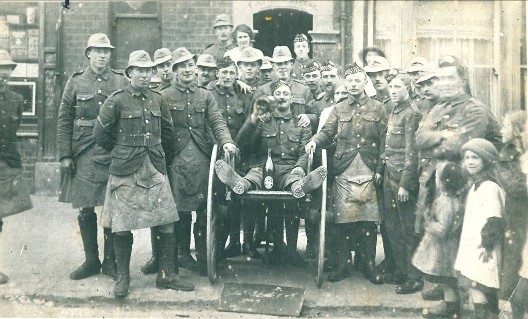
Men of the 5th Seaforth Highlanders posing in Garfield
Street. The residence in the background is a terraced
property, Garfield House.
Garfield Street is within
the 'Prime Ministers' area of town (also coloquially
known as 'Black Tom') bordered by Roff Avenue, Foster
Hill Road and Clarendon Street. The streets within this
district were home to the 5th Seaforth from August 1914
to May 1915.
The man sitting in the cart and drinking
from a bottle of Charles Wells beer is believed to be
one Tom McLennan, whose wife was apparently far from
impressed when she saw the photo! The reason for the
celebration is unknown.
Of particular note in this
picture are the distinctive, brimmed items of headwear
worn by several of the men. These were actually canvas
covers for the Glengarry and were a short-lived
innovation which only the 5th and 6th Seaforth appear to
have been issued with a month, or so, before the
Highland Division left Bedford for France. The idea
behind the design was that the brim of the hat would
provide the wearer's head and face with a greater degree
of protection in wet weather.
By the time the
Highlanders arrived in France, Scottish regiments were
replacing their Glengarries with the Balmoral bonnet, an
item of headwear more akin to a beret in appearance,
which soon gave way to the broader-brimmed Tam o'Shanter. The 'Tammie'was then standard issue to
Highland regiments for the remainder of the war.
(photo: courtesy of Richard Galley)
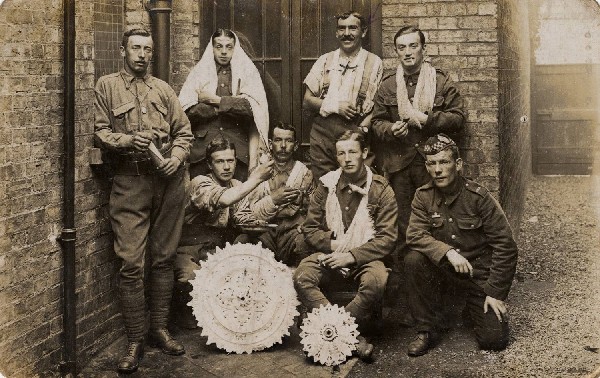
This photograph (Bedford & Luton Archives and Records
Service) includes several of the men who appear in the
image of no. 3 Section 'C' Company, 9th Argyll and
Sutherland Highlanders outside 23 Goldington Avenue.
In this photo, Charlie Doig is marked with a cross. The
men appear to be re-enacting the inoculation process and
have torn up their towels to make makeshift slings. The
man at the back with a towel on his head seems to be
playing the part of Matron!
Of particular note are
the moulded plaster ceiling roses which are being
displayed like trophies. In the winter of 1914/15
firewood and coal seem to have been in very short supply
for the men in unfurnished billets. So much so that they
resorted to dismantling the houses they were living in
to find anything to burn; floor boards, banisters,
internal doors etc. all seemed to be fair game. It's
likely that Charlie Doig and his mates had taken down
the ceilings to get to the wooden laths under the
plaster.
The County archive holds several letters
sent from property owners and letting agents to the
authorities complaining about the state that unfurnished
billets were left in when the Highlanders marched-out.
In fact, the Welsh Division arrived in Bedford almost as
soon as the Scots had left and were due to take over the
recently vacated billets. They were unable to do so
until the properties were renovated.
One can't
really blame the men in such circumstances. It was a
particularly bleak winter, many of the men were sick and
those living in unfurnished billets had little, or
nothing, in the way of creature comforts, least of all
the means to keep warm.
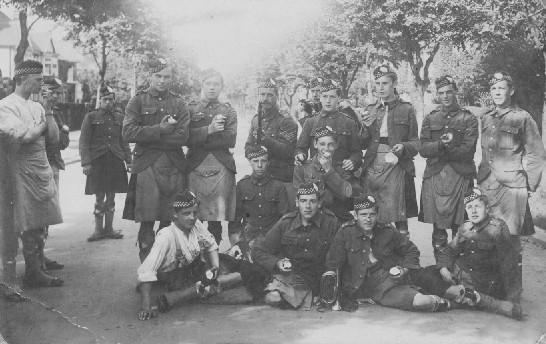
Members of the 7th Argyll and Sutherland Highlanders enjoying their off-duty time and posing for the camera in the middle of Bushmead Avenue, Bedford on a warm afternoon in late August 1914. (photo: courtesy of Richard Galley)
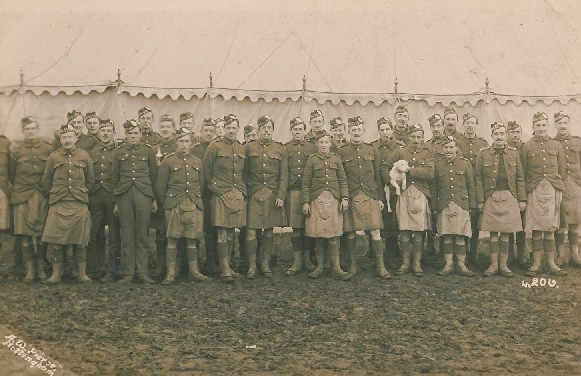
The local theatres, music halls and cinemas provided
options for off duty soldiers and a number of canteens,
reading and recreation rooms were established by
organisations as diverse as the YMCA, the Bedford
Borough Recreation Committee for the Troops and United
Free Church of Scotland.
"By the end of August
1914, fifteen recreation rooms were opened, and in the
subsequent four months there were no fewer than
forty-seven centres in Bedford. During the first three
months seventeen concert parties were organised to visit
Canteens in Bedford and neighbourhood, including the
camps at Haynes and Howbury Parks"
'A Record of
Four and Half Years Voluntary Work'; J.Hamson – pub. by
Bedford Borough Recreation Committee for the Troops May
1919
The central canteen was established in
Bedford's Corn Exchange, with smaller facilities being
set up in church and community halls in and around
Bedford. During the Highlanders'time in town it was
calculated that 2cwt of porridge were being served each
day by the Corn Exchange canteen alone.
In this
photograph taken in Russell Park, Bedford, Argyll and
Sutherland Highlanders pose outside the recreation tent
which had been erected for the use of men billeted in
the local area.
Recreation tents were located in all
the Division's billeting districts and provided the men
with somewhere to go to obtain refreshments, relax with
their friends, borrow books from small lending libraries
and obtain stationery for catching up with their
correspondence.
(photo: courtesy of Richard Galley)
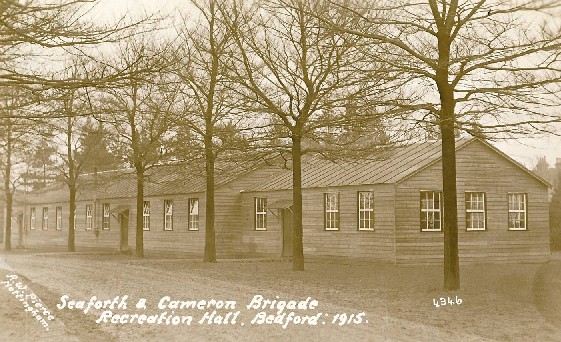
As autumn gave way to winter in 1914, the authorities
realised that the recreation tents in each billeting
area were no longer adequate for providing sufficient
shelter. The tents were replaced by more substantial,
semi-permanent wooden huts and the example shown in this
photograph was located in Bedford Park for use by men of
the Seaforth and Cameron Brigade who were billeted in
the district.
(photo: courtesy of Richard Galley)
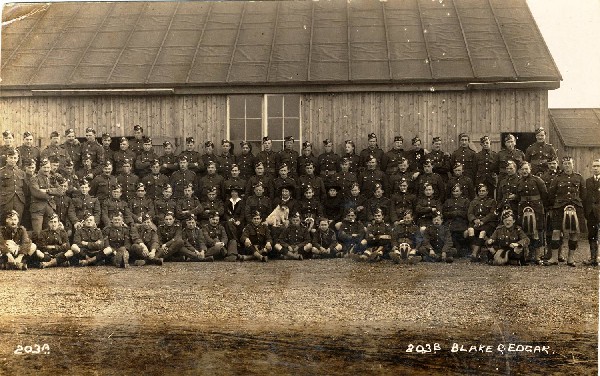
Gordon Highlanders pose outside their recreation hall
located in Hurst Grove, Bedford. Some of the local
people who ran the facility are included in the photo. (Photograph: courtesy of Richard Galley)
"What a lot the division owed to Bedfordians – and
to the women particularly. We thrived on their kindness.
Seventeen thousand men on full pay bring a lot of money
into a town; and while our thoughts were engrossed on
training for war every big and little shop blossomed
into a canteen, and every public house took thought how
it could increase its stature. But all of the natives of
Bedford were not shopkeepers and publicans, and a least
half of the inhabitants were making no wealth from
billeting. We can have brought neither pleasure nor
profit to a goodly proportion – to the old gentlemen who
made us welcome at their clubs; to the middle-aged
ladies whose peace of mind we shattered. Yet we received
from all the greatest kindness."
'Behind the
Lines'; Col W.N. Nicholson, CMG, DSO – Jonathan Cape Ltd
1939
"We have been asked to express to the people of
Bedford the Commanding Officers'grateful recognition of
the many acts of kindness bestowed on their men, and to
express the hope that the townsfolk will refrain from
buying the men intoxicating liquors"
Bedfordshire Times and Independent 21/8/14
"The conduct of
the men here has been wonderfully good. There are now
25,000 Scotsmen here just now, and as you know the
English always blame the Scottish for drunkenness. Well
a drunk "Tommy" is about the scarcest thing in Bedford,
and during the six months we have been here out of 140
men under me, I have only had one man in front of me for
being drunk."
Letter from Capt. Stewart Coats,
Argyll and Sutherland Highlanders, Bedford 1915
This
photograph captures the scene outside the Gordon Arms,
Castle Road, Bedford one sunny summer afternoon in 1914.
Argyll and Sutherland Highlanders enjoying their off
duty time in the company of local people.
Page last updated: 15th July 2014
